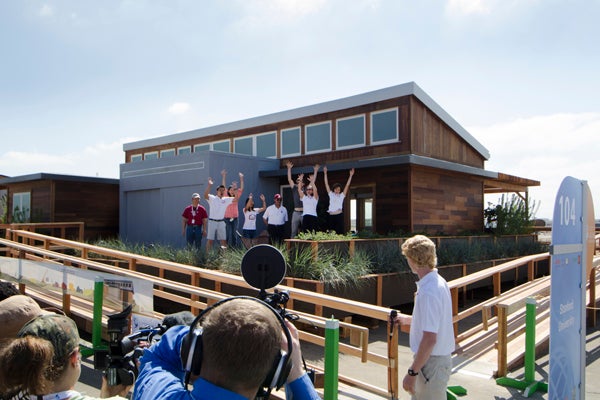|
March 28, 2013
Construction begins for Stanford's student-designed solar house
The solar-powered Start.Home, designed and built by Stanford students, runs on a standardized platform that students believe could transform green home construction. By Bjorn Carey

Stanford students, from right, Erica Levine, Yoo-Yoo Yeh, Claire Frykman, and classmates prepare to place floor joists that will support a deck at the Start.Home. (Photo: Linda A. Cicero / Stanford News Service)
The floors have been laid, the walls are up, and a crane will soon drop roofing into place.
Stanford's Start.Home, a student-designed, net-zero emissions house, is taking shape. (Follow the progress via time-lapse videos on the project's YouTube channel.)
The two-bedroom, one-bath house is Stanford's entrant in the Solar Decathlon, a biennial competition run by the U.S. Department of Energy that challenges students to design and build innovative solar houses that will help usher green technology into modern home construction. The 2013 competition will feature solar homes from 20 collegiate teams from four countries.
To help achieve net-zero emissions status, the Start.Home will run on a 7kW photovoltaic system, which will provide an average of 30 kilowatt-hours of energy from the sun daily. Foam insulation sandwiched in the exterior walls will create a tight seal around the house to minimize energy spent on heating and cooling, which will balance out the foam's negative environmental impacts.
At the heart of the project is the Start.Core, a central unit that contains all the plumbing, utilities and appliances and manages the house's energy usage. The team believes that a standardized unit like the Start.Core could transform green home construction.
"We want to inspire industry to think about houses that can be built more like cars," said project manager Derek Ouyang, a double major in civil engineering and architectural design.
The ability to mass produce basic but critical elements will make it possible to improve quality control and upgrade equipment with new technology as it becomes available, while at the same time allowing customizability. "The Start.Core is like an engine for homes, and you can build any shell you want around it," he said.
Most of the students had no carpentry experience before beginning the build, but they are gaining on-site training from five instructors from the Carpenters Union, one of the project's sponsors. After a few hours on the site with the expert instructors, Ouyang said, most students feel very comfortable with the construction equipment.
Learning their way around a construction site, however, hasn't been the only challenge.
"Every single day we run into five unexpected issues," Ouyang said. "Most of them are structural. When you're designing something using 3-D software, it looks really easy to drop in a beam or a screw. But then you finally get building, and you realize you can't swing a hammer in the space where you planned to put a nail. I've spent most of my time so far going around the site figuring out on-the-spot design changes."
Earlier this week, 100 6th-graders from nearby Nueva School visited for a tour of the house. A public house-warming ceremony is scheduled for Earth Day, April 22, and the team has plans for more educational tours this summer, when the core systems are fully integrated. Ouyang said that these outreach efforts will help people think about improving their day-to-day energy consumption.
"We're packaging behavioral design into the Start.Core, to help people become net-zero as well," Ouyang said. "The more aware you are of your daily energy usage, the more likely you are to improve your habits. That's hard to do just based on an electric bill at the end of the month."
This summer the team also will be fine-tuning the operating systems and confirming that the house is really operating at net-zero emissions.
Later this summer, the team will practice dismantling and re-assembling the house in preparation for the competition, which will be held October 3-13 at Orange County Great Park in Irvine, Calif.
-30-
|